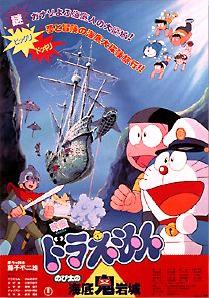
Doraemon: Nobita and the Castle of the Undersea Devil is a 1983 Japanese animated science fantasy film and the fourth Doraemon feature film, released on March 12, 1983, in Japan. Being the first film in the series to be directed by Tsutomu Shibayama, the film is loosely based on the Western myth of Atlantis, the mythical continent of Mu and the 1980 chapter "8 Days at the Dragon King's Palace".

Doraemon: Nobita's Great Adventure into the Underworld, also known as Doraemon, Nobita and the Underworld Adventure, is a 1984 Japanese animated science fantasy film which premiered on March 17, 1984, in Japan, based on the fifth volume of the same name of the Doraemon Long Stories series. The fifth in series, it was the first to incorporate computer graphics technology. The film was watched by more than 3 million people and generated a revenue of 1.65 billion yen. It became the highest grossing animated film of 1984. By its release, Doraemon became the first and the only franchise to have 2 back-to-back highest-grossing animated films of the year. A remake of this film was released in Japan on March 10, 2007, entitled Doraemon: Nobita's New Great Adventure into the Underworld. It is the 5th Doraemon film.
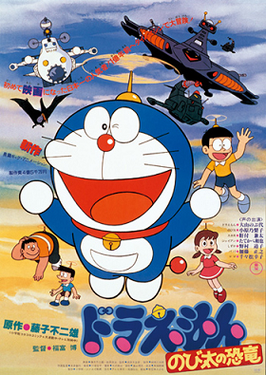
Doraemon: Nobita's Dinosaur is a 1980 Japanese animated science fiction adventure film based on the manga series Doraemon, particularly the first volume of the same name of the Doraemon Long Stories series. The film premiered on 15 March 1980 in Japan. It is the first feature-length Doraemon film. In 2006, the film was remade as Doraemon: Nobita's Dinosaur 2006. It is an expanded version of the 1975 chapter with the same name.

Doraemon: Nobita and the Haunts of Evil is a 1982 Japanese animated science fiction adventure film based on the third volume of the same name of the Doraemon Long Stories series. It was released on 13 March 1982 in Japan. It's the 3rd Doraemon film and was animated by Shin-Ei Animation. A remake of this film was released on March 8, 2014, entitled Doraemon: New Nobita's Great Demon—Peko and the Exploration Party of Five. It is partially inspired by the 1980 chapter "Nobita's Rescue Party".

Doraemon: Nobita's Little Star Wars is a 1985 Japanese animated epic space opera film. It is a feature-length Doraemon film which premiered in Japan on March 16, 1985. As the film's title suggests, it is a parody of George Lucas' original Star Wars trilogy, with a few elements from his 1983 film Return of the Jedi. The film is directed by Tsutomu Shibayama. The theme song of this film is performed by Tetsuya Takeda. It's the 6th Doraemon film. The remake of the film, Doraemon: Nobita's Little Star Wars 2021 has been released on 4 March 2022.

Doraemon: Nobita and the Knights on Dinosaurs is an 1987 Japanese animated epic science fiction film and the eighth feature-length Doraemon film which premiered on March 14, 1987 in Japan, based on the eighth volume of the same name of the Doraemon Long Stories series. It was the highest-grossing animated film of the year 1987.
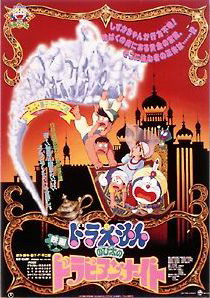
Doraemon: Nobita's Dorabian Nights, also known as Doraemon Nights, is a 1991 Japanese animated science fantasy film which premiered on 9 March 1991 in Japan, based on the 11th volume of the same name of the Doraemon Long Stories series. It's the 12th Doraemon film.

Doraemon: Nobita and the Kingdom of Clouds, also known as Doraemon and the Kingdom of Clouds, is a feature-length Doraemon film which premiered on March 7, 1992, in Japan, based on the 12th volume of the same name of the Doraemon Long Stories series. It is the 13th Doraemon film.
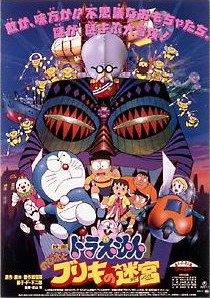
Doraemon: Nobita and the Tin Labyrinth is a 1993 Japanese animated science fiction adventure film which premiered on 6 March 1993 in Japan, based on the 13th volume of the same name of the Doraemon Long Stories series. It is the 14th Doraemon film.

Doraemon: Nobita's Three Visionary Swordsmen is a 1994 Japanese animated science fantasy film which premiered in Japan on March 12, 1994, based on the 14th volume of the same name of the Doraemon Long Stories series. This film marks the 15th anniversary of the Doraemon television series on TV Asahi. It's the 15th Doraemon film.
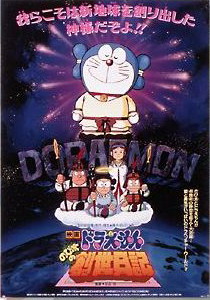
Doraemon: Nobita's Diary on the Creation of the World is a 1995 Japanese animated science fiction drama film which premiered on March 4, 1995, in Japan, based on the 15th volume of the same name of the Doraemon Long Stories series. It is the 16th Doraemon film. It is based on the 1973 chapter "Planet Builders".
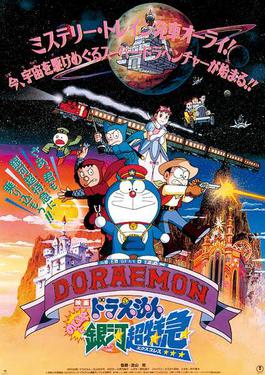
Doraemon: Nobita and the Galaxy Super-Express, also known as Doraemon and the Galaxy Express, is a 1996 Japanese animated science fiction neo-Western film and the 17th feature-length Doraemon film. It premiered in Japan on March 3rd, 1996, based on the 16th volume of the same name in the Doraemon Long Stories manga series.

Doraemon: Nobita and the Winged Braves, also known as Doraemon and the Winged Warriors, is a 2001 Japanese animated science fiction adventure film which premiered in Japan on 10 March 2001, based on the 21st volume of the same name of the Doraemon Long Stories series. It's the 22nd Doraemon film. This is the first new millennium and new century-era Doraemon movie.

Doraemon: Nobita and the Windmasters, also known as Doraemon and the Wind People, is a 2003 Japanese animated science fantasy film which premiered on March 8, 2003 in Japan, based on the 23rd volume of the same name of the Doraemon Long Stories series. It is the 24th Doraemon film. It is partly based on the 1974 chapter "Phoony the Typhoon".

Doraemon: The Record of Nobita's Parallel Visit to the West, also known as Doraemon's Parallel Journey to the West, is a 1988 Japanese animated science fantasy film which premiered on March 12, 1988 in Japan. It is loosely based on the 16th-century novel Journey to the West. It is the 9th Doraemon film, which is the last Shōwa era Doraemon film.
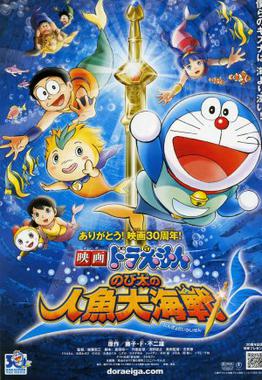
Doraemon: Nobita's Great Battle of the Mermaid King is a 2010 Japanese animated science fantasy action adventure film based on the manga and anime series Doraemon, and is the 30th Doraemon film. The film was released in Japan on March 6, 2010.

Doraemon: New Nobita's Great Demon—Peko and the Exploration Party of Five is a 2014 Japanese animated science fiction adventure film. It is a remake of the 1982 film, Doraemon: Nobita and the Haunts of Evil. The film was released on 8 March 2014 in Japan & 4 August 2016 in United States. It's the 34th Doraemon film. This movie was the 5th highest grossing animated film of 2014 anime in Japan. The opening theme song is "Yume o Kanaete Doraemon", performed by MAO and the ending theme song is "Hikari no Signal" performed by Kis-My-Ft2.

Doraemon: Nobita's Space Heroes, also known as Doraemon The Super Star 2015 and later as Doraemon the Movie 35th is an anime science fiction action adventure film and the 35th Doraemon film. Released in Japan on 7 March 2015, it commemorates the 35th anniversary of the Doraemon (1979) anime series and the 10th anniversary of the Doraemon (2005) anime.
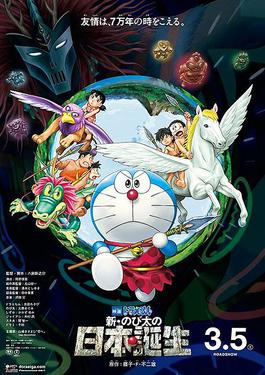
Doraemon: Nobita and the Birth of Japan 2016 is a 2016 Japanese animated science fiction adventure film written and directed by Shinnosuke Yakuwa. It is the 36th feature film of Doraemon franchise. It is a remake of the 1989 film Doraemon: Nobita and the Birth of Japan. The film is about the adventure of Nobita and his friend in Japan, 70,000 years ago. The taglines were "Friendship could cross over space-time", "Daddy, I saw the birth of Japan in 21st century", "We can see the birth of Japan in 21st Century" and "Some of the secrets only have in Japan".

Doraemon: Nobita's Chronicle of the Moon Exploration is an anime epic science fiction film directed by Shinnosuke Yakuwa and screenplay provided by Mizuki Tsujimura. It was premiered in Japan on 1 March 2019.




















